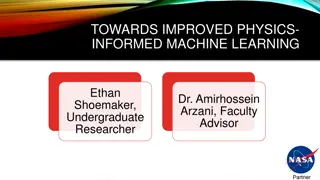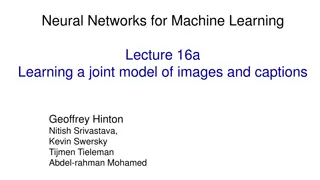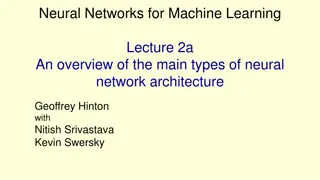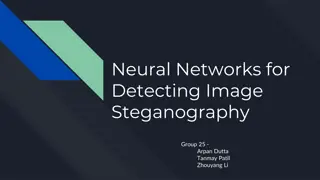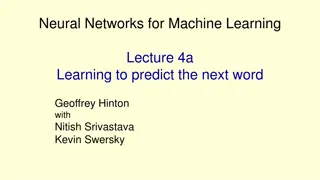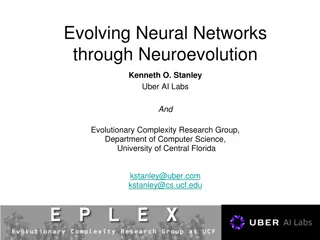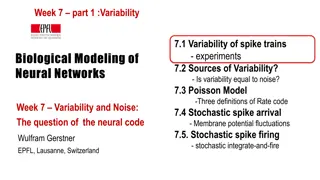Understanding Neural Networks: Concepts and Contrasts
Neural Networks (NNs) are parallel and distributed processing systems where representation is distributed across a network structure. Unlike semantic networks, individual nodes in NNs do not inherently carry meaning. NNs are trained, not programmed, offering graceful degradation and are inspired by brain structures, but differ significantly. They excel at solving specific problems and are not synonymous with brains. NN structure and learning algorithms vary, presenting a unique approach to problem-solving.
Download Presentation

Please find below an Image/Link to download the presentation.
The content on the website is provided AS IS for your information and personal use only. It may not be sold, licensed, or shared on other websites without obtaining consent from the author. Download presentation by click this link. If you encounter any issues during the download, it is possible that the publisher has removed the file from their server.
E N D
Presentation Transcript
Neural Networks NNs are a study of parallel and distributed processing systems (PDPs) the idea is that the representation is distributed across a network structure an individual node itself does not have meaning, or does not represent a concept, unlike a semantic network NN terminology is similar to that of neurology, but don t confuse a NN and the brain, there are far more differences than similarities below are some example NN structures
NN Appeal They are trained rather than programmed so development does not entail the cost of an expert system They provide a form of graceful degradation if part of the representation is damaged (destroyed, removed), the performance degrades gracefully rather than completely as with a brittle expert system which might lack the proper knowledge They are particularly useful at solving certain classes of problems low-level classification/recognition optimization content addressable memory Most of these problems are very difficult to solve by expert system
Inspiration from the Brain NNs are inspired by the structure of neurons in the brain neurons connect to other neurons by synapses neurons will fire which sends electrochemical activity to neighboring neurons across synapses if the neuron excites another neuron, then the excited neuron has a greater chance to fire such a connection (or link) is known as an excitation link if the neuron inhibits another neuron, then the inhibited neuron has less of a chance to fire this is an inhibition link
NNs Are Not Brains The NN uses the idea of spreading activation to determine which nodes fire and which nodes do not The NN learns whether a node should excite or inhibit another node by adjusting the edge weights on the link between them but this analogy should not be taken too far! NNs differ greatly in structure and learning algorithms, we will explore the earliest form for an introduction before looking at several newer and more useful forms the interesting aspects, as noted, are that NNs are trained rather than programmed that they are superior at solving certain low-level tasks than symbolic systems that they can achieve graceful degradation
An Artificial Neuron What should the values of the weights be? These are usually learned using a training data set and a learning algorithm A neural network is a collection of artificial neurons the neuron responds to input, in this case coming from x1, x2, , xn the neuron computes its output value, denoted here as f(net) the computation for f(net) takes the values of the inputs and multiplies each input by its corresponding weight x1*w1 + x2*w2 + + xn*wn different types of neurons will use different activation functions with the simplest being if x1*w1 + x2*w2 + + xn*wn >= t then f(net) = 1 else f(net) = -1
Early NNs First proposed in 1943, the McCulloch-Pitts neuron uses the simple comparison shown on the previous slide for activation The perceptron, introduced in 1958 is similar but has a learning algorithm so that the weights can be adjusted when training examples are used so that the perceptron learns What the perceptron is learning is the proper weights on each edge so that the function f(net) properly computes whether an input is in a class or not if instance I is in the class, we expect the weights to be adjusted so that f(I) = 1 and if J is not in the class, we expect f(J) = -1
Perceptron Learning Algorithm Let the expected output of the perceptron be di Let the real output of the perceptron for this input be oi Let c be some constant training weight constant Let xj be the input value for input j For training, repeat for each training example i wi = (di oi) * xi collect all wi into a vector and then set w = w + w * c that is, wi = wi + c * (di - oi) * xi for each i Repeat the training set until the weights are not changing Notice that dj oj will either be +2, 0, or -2 so in fact we will always be altering the weights by +2*c, 0*c or -2*c Note that in a perceptron, we add an n+1st input value with a weight of 1, known as the bias
Examples The above perceptrons perform the functions X AND Y and X OR Y notice that the weights have been pre- set, we would prefer to use the training algorithm instead the table on the right can be used to train a perceptron to output the desired value (this table represents the data points shown to the left)
Learning the Weights Given the previous table for data, we train the above perceptron as follows starting off with edge weights of [.75, .5, -.6] for w1, w2, w3 respectively and c = .2 these weights are randomly generated f(data1) = f(.75*1+.5*1+-.6*1) = 1 correct answer, do not adjust the weights f(data2) = f(.75*9.4 + .5*6.4+-.6*1) = 1 incorrect answer, so adjust weights by -2*.2 = -.4 [.75 + -.4*9.4, .5 + -.4*6.4, -.6 + -.4*1] = [-3.01, -2.06, -1.00] f(data3) = f(3.01*2.5+-2.06*2.1+-1.00*1) = -1, incorrect answer, so adjust weights again by -.4 [-3.01+-.4*2.5, - 2.06+-.4*2.1, -1.00+-.4*1] = [-2.01, -1.22, -.60]
Continued We do this for the entire training set (in this case, 10 data from the previous table) at this point, the weights have not become stable to be stable, the weights cannot change (more than some small amount) between training examples So we repeat the entire process again, redoing each training example For this example, it took 10 iterations of the entire training set before the edge weights became stable that is, the weights converge to a stable set of values The final weights are [-1.3, -1.1, 10.9] this creates a formula for f(net) of 1 if x1*-1.3 + x2*-1.1 + 1*10.9 >= 0 0 otherwise
Perceptron Networks The idea behind a single perceptron is that it can learn a simple function but a single perceptron can be one neuron in a larger neural network that can perform a larger operation based on lesser functions unfortunately, the perceptron learning algorithm can only train a single perceptron, not perceptrons connected into a network The intention of a perceptron network is to have some perceptrons act as low-level data transformers have some perceptrons act as low level pattern matchers have some perceptrons act as feature detectors have some perceptrons act as classifiers
Linear Separability Imagine the data as points in an n-dimensional space for instance, the figure below shows data points in a 2-D space (because each datum has two values, x1 and x2) what a perceptron is able to learn is a dividing point between data that are in the learned class and data that are not in the learned class This only works if the division is linearly separable in a 2-D case, it s a simple line in a 3-D case, it s a plane in a 4-D case, it s a hyperplane The figure to the right shows a line that separates the two sets of data those where the perceptron output is 1 (in the learned class) and those where the perceptron output is -1 (not in the learned class)
What Problems Are Linearly Separable? This leads to a serious concern about perceptrons just what problems are linearly separable? if a function is not linearly separable, a perceptron can t learn it we have seen the functions X AND Y, X OR Y, and a function to classify the data in the previous figure are linearly separable what about the XOR function? see the figure to the right There is no single line that can separate the points where the output is 1 from the points where the output is 0! XOR cannot be learned by perceptron! A perceptron network can solve XOR but we cannot train an entire network
Threshold Functions The perceptron provides a binary output based on whether the function computed (x1*w1+x2*w2+ ) >= t or <t such a function is known as a linear threshold (or a bipolar linear threshold) When we connect multiple neurons together to form a perceptron network, we may want to allow for perceptron nodes to output other values, for instance, values in between the extremes To accomplish this, we need a different threshold function The most common threshold function is known as the sigmoid function This not only gives us in-between responses, but is also a continuous function, which will be important for our new training algorithm covered next The sigmoid function is denoted as 1/(1+e-gamma*net) where net is again the summation of the inputs * weights x1 * w1 + x2 * w2 + x3 * w3 + xn * wn and gamma is a squashing parameter, often set to 1
Comparing Threshold Functions a squashed sigmoid function makes the steepness more pronounced In the sigmoid function, output is a real number between 1 and 0 the slope increases dramatically near the threshold point but is much more shallow once you get beyond the threshold for instance net = 0 means 1 / (1 + e-0) = net = 100 means 1 / (1 + e-100) which is nearly 1 net = -100 means 1 / (1 + e100) which is nearly 0
Gradient Descent Learning Imagine that the n edge weights of a perceptron are plotted in an n+1 dimensional space where one axis represents the error rate of the perceptron the optimal value of those edge weights represents the weights that will ensure that the perceptron is always correct (no error) we want a learning algorithm that will move the edge weights closer and closer to that optimal location this is a process called gradient descent see the figure below the idea is to minimize the error for a perceptron, we can guarantee that we will reach the global minima (the best set of values for the edge weights) after enough training iterations but for other forms of neural networks, training might cause the edge weights to descend to a local minima
Delta Rule Many of the training algorithms will take a partial differential of the summation value used to compute activation (what we have referred to as f(net)) we have to move from the bipolar linear threshold of the perceptron to the sigmoid function because the linear threshold function is not a continuous function We will skip over most of the math, but here s the basic idea, with respect to the perceptron using the sigmoid function weight adjustment for the edges into perceptron node i is c * (di Oi) * f (neti) xj c is the constant training rate of adjustment di is the value we expect out of the perceptron Oi is the actual output of the perceptron f is the threshold function so f is its partial derivative xj is the jth input into the perceptron
Feed-Forward Back-Propagation Network The most common form of NN today is the feed- forward network we have layers of perceptrons where each layer is completely connected to the next layer and the preceeding layer each node is a perceptron whose activiation function is the sigmoid function We train the network using an algorithm called back- propagation so the network is sometimes referred to as a feed-forward back-prop network unlike a perceptron network, all of the edge weights in this network can be trained because the back-prop algorithm is more powerful, but it is not guaranteed to learn, and may in fact get stuck in a local minima
The FF/BP Network The network consists of some number of input nodes, most likely binary inputs, one for each feature in the domain There is at least one hidden layer, possibly more the network is strongly connected between layers an edge between every pair of nodes between two consecutive layers Most likely, there will be multiple output nodes, one for each class being recognized The output node(s) will deliver a real value between 0 and 1 but not exactly 0 or 1, so we might assume the highest valued output node is the proper class if we have separate nodes for every class being recognized
Training For each item in the training set take the input values and compute the activation value for each node in the first hidden layer pass those values forward so that node wki gets its input from the previous layer and broadcasts its results to the next layer continue to feed values forward until you reach the output layer compute what the output should have been back propagate the error to the previous level, adjusting weights continue to back propagate errors to prior levels until you reach the final set of weights Repeat until training set is complete if the edge weights have not reached a stable state, repeat
More Details The output of any node (aside from the input nodes which are 1 or 0) are computed as f(net) = 1 / (1 + e-g*net) where g is the squashing parameter and can be 1 if desired (note: in the book, g is the Greek letter gamma) and net is the summation xi*wi for all i recall for the perceptron, f(net) was either -1 or +1 here, f(net) will be a real number > 0 and <= 1 Compute the error for the edge weight from node k to output i to readjust the weight weightki = weightki + -c * (di Oi) * Oi * (1 Oi) * xk c is the training constant di is the expected value of the output node I Oi is the actual value computed for node I xk is the value of node xk from the previous layer
The Hidden Layer Nodes What about correcting the edge weights leading to hidden layer nodes? this takes some extra work In a perceptron network, a node represented a classifier In a FF/BP network input nodes represent whether an input feature is present or not output nodes represent the final value of the network (for instance, which of n classes the input was classified as) but hidden layer nodes don t represent anything specifically unlike a semantic network or perceptron network or any other form of network that we have investigated where a node represents something
Continued A node in a hidden layer makes up a subsymbolic representation it is a contributing factor toward recognizing whether something is in a class or not, but does not itself represent a specific feature or category When correcting the output layer s weights (that is, the weights from the last hidden layer to the output layer), we know what an output node s value should be for instance, if we are trying a cat example, then the dog node should output a 0, if it output a non-zero value, we know it is wrong To correct a hidden layer node, k, we need to know what the output of i should have been (di) but since the node doesn t represent anything specific (a calss, a feature), how do we know what the value should have been? so we need to use a different approach when adjusting weights of hidden layer nodes
Training a Hidden Layer Node Since we don t know what di should be, we can t use it to compute di Oi as we did with the output layer this is where the partial differential of the error rate (the delta rule) comes in For a hidden layer node i, we adjust the weight from node k of the previous (lower) level as wik = wik + -c * Oi * (1 Oi) * Sumj (- deltaj * wij) * xk where Sumj adds up all of the errors * edge weights of edges coming out of node i to the next level (-deltaj is the error from the jth node in the next level that this node connects too) the error is either the error directly computed if the next level is an output level, or the error computed using the above formula if it is a hidden layer in a network with a single hidden layer, the value of deltaj is merely the error of output node j, which is merely (dj Oj) note that the minus signs in -c and -delta will cancel giving us wik = wik + c * Oi * (1 Oi) * Sumj (deltaj * wij) * xk
Training the NN While a perceptron can often be trained using a few training examples, the NN requires dozens to hundreds of training examples one iteration through the entire training set is called an epoch it usually takes hundreds or thousands of epochs to train a NN with 50 training examples, if it takes 1,000 epochs for edge weights to converge, then you would run the algorithm 20,000 times! The interesting thing to note about a NN is that the training time is deeply affected by initial conditions size, shape of the NN or initial weights The figure to the right, although not very clear, demonstrates training a 2x2x1 NN to compute XOR using different starting conditions where the shade of grey represent approximate number of epochs required A slight change to the initial conditions can result in a drastically changed training time
FF/BP Example: Learning XOR A perceptron cannot learn XOR and a perceptron network does not learn at all (we can build a perceptron network with weights in place, but we derive those weights) Here is a FF/BP net that learns XOR Our training set is multiple instances of the same 4 data [0, 0] 0 [1, 0] 1 [0, 1] 1 [1, 1] 0 Initial weights are WH1 = -7, WH2 = -7 WHB = 2.6, WOB = 7 WO1 = -5, WO2 = -4, WHO = -11 The network converges in 1400 epochs Notice that the input nodes go to both the hidden layer and the output node adding two extra edge weights and both layers have a bias See pages 473-474 for some examples of how the values are fed forward
FF/BP Example: NETtalk English pronunciation for a given letter (phoneme) depends in part on the phonemes that surround it for instance, the th in with differs from the and wither NETtalk is a program that uses a neural network to generate what an output should sound like input is a window of 7 letters (each represented one of 29 phonemic sounds) so the input is 7*29 nodes the desired sound is the middle of the 7 letters, for instance if the input is a c a t then we are looking for the sound for the c represent word boundaries there is a hidden layer of 80 nodes including 1 bias node the output consists of 21 phonetic sounds and 5 other values that indicate stress and syllable boundary the network consists of 18,629 edges/edge weights NETtalk was trained in 100 epochs and achieved an accuracy of about 60% ID3 was trained with the same data set (ID3 only performs 1 pass through the training set) and achieved similar results
Competitive Learning A winner-take-all competitive form of learning can be applied to FF networks without using the reinforcement step of backprop when an example is first introduced, the output node with the highest value is selected as a winner edge weights from node i to this output node are adjusted by c*(xi wi) c is our training constant xi is the value of input node i wi is the previous edge weight from node i to this node We are strengthening the connection of this input pattern to this node If input patterns differ sufficiently, different output nodes will be strengthened for different types of inputs the common application for this learning algorithm is to build self-organizing networks (or maps), often called Kohonen networks
Example: Clustering Using the data from our previous clustering example the Kohonen network to the left learns to classify the data clusters as prototype 1 (node A) and prototype 2 (node B) over time, the network organizes itself so that one node represents one cluster and the other node represents the other cluster Like the clustering algorithm mentioned in chapter 10, this is an example of unsupervised learning See page 477-478 for example iterations of the training of this network
Support Vector Machines SVMs are not actually neural networks but they act similar to perceptrons so we briefly cover them here An SVM uses a set of data points to learn a separation point between data in a class versus not in the class the SVM typically uses linear regression analysis by comparing the data points in versus not in the class This separation point is an n-dimensional hyperplane where each data point has n values we refer to the SVM as a linear classifier this is the same as a perceptron Recall that what doomed the perceptron was the discovery that most problems are not linearly separable
Why SVMs? Given that an SVM does the same thing as a perceptron (in a different way), why would SVMs be of any interest? Two reasons first, the SVM does not guarantee that the hyperplane completely subdivides the data into ins versus outs , instead it attempts to create a hyperplane which gives the best probability of being correct this is known as a soft margin second, while a hyperplane in n dimensions may not be possible, a hyperplane of fewer dimensions is, the SVM uses various transformation algorithms to reduce the dimensionality of the problem into one where a hyperplane can be fitted this is known as a kernel trick the most common kernel functions are polynomial functions, Gaussian distribution-based (radial basis) functions and hyperbolic tangent functions
Example Here we see the result of applying 4 different kernels to a collection of data Notice the linear kernel only creates hyperplanes while the polynomial kernel creates curves and the RBF (radial basis function) kernel creates a more complex geometric shape
Variations of SVMs The SVM doesn t have to be limited to ins versus outs but instead is often used to classify between one of two classes this doesn t need anything special in that we might consider the data in class 1 to be the ins and the data in class 2 to be the outs Multiclass SVMs are really just a collection of SVMs, one per class being learned that is, each SVM is a binary classifier (a datum is in that class or it is not) the collection of SVMs then should lead to any datum being classified by exactly one in the collection Transductive SVMs use semi-supervised learning only some of the data in the training set is correctly classified, the rest is unclassified these types of SVMs are often used in natural language understanding situations where we don t have the ability to clearly annotate every training sentence
SVM Applications There are a number of different reasons to use SVMs but to date, their biggest AI uses have been Text mining for instance, classifying the grammatical role of a word in a sentence (verb, noun, adverb, etc) Image classification Hand-written character classification Classification of proteins in medical science Disease classification (e.g., cancer diagnosis) Financial forecasting and decision trees Speaker recognition (i.e., identifying a speaker, not the words) Prediction of traffic patterns Computer system intrusion detection Environment sciences data analysis Optimization problems
Coincidence Learning This is a condition-response form of learning In this type of learning, there are two sets of inputs the first set is a condition that should elicit the desired response the second set of inputs is a second condition that needs to learn the same response as the first set of inputs The author, by way of an example, uses the Pavlovian example of training a dog to salivated at the sound of a bell no matter if there is food present or not initially, the dog salivates when food is present a bell is chimed whenever food is presented so that the dog becomes conditioned to salivate whenever the bell chimes once conditioned, the dog salivates at the sound of the bell whether food is present or not
Hebbian Network A Hebbian network (see below) is used for this form of learning the top three inputs below represent the initial condition that we learn first once learned, the task is for the network to learn the weights for the bottom three inputs so that a different input condition will elicit the same output response We will use Hebbian learning in both supervised and unsupervised ways
Unsupervised Hebbian Learning Assume the network is already trained on the initial condition (e.g., sight of food) And we train it on the second condition (e.g., sound of a bell) the first set of edge weights are stable, we will not adjust those the second set of edge weights are initialized randomly (or to all 0s) Provide training examples that include both initial and new conditions But update only the second set of edge weights using the formula: wi = wi + c * f(X, W) * xi wi is the current edge weight c is the training constant f(X, W) is the output of the node (a +1 or a -1) xi is the input value What we are in essence doing here is altering the latter set of edge weights to respond in the same way as the first set of edge weights when the training example contains the same condition for both sets of inputs the book steps through an example on pages 486-488
Supervised Hebbian Learning Here, we want the network to learn associations map an input to an output we already know the associations Use a single layered network where inputs map directly to outputs the network will be fully connected with n inputs and m outputs We do not need to train our edge weights but instead compute them using a simple vector dot product of the training examples combined the formula to determine the edge weight from input i to output k is wik = c * dk * xi where c is our training constant dk is the desired output of the kth output node and xi is the ith input We can compute a vector to adjust all weights as once with W = c * Y * X where W is the vector of weights and Y * X is the outer product of a matrix that stores the associations (see the next slide)
Example We have the following two associations [1, -1, -1, -1] [-1, 1, 1] [-1, -1, -1, 1] [1, -1, 1] That is, input of x1 = 1, x2 = -1, x3 = -1 and x4 = -1 should provide the output of y1 = -1, y2 = 1, y3 = 1 The resulting network is shown to the right notice every weight is either +2, 0 or -2 this is computed using the matrix sum shown to the right
Associative Memories Supervised Hebbian networks are forms of linear associators heteroassociative the output provided by the linear associator is based on whatever vector the input comes closest to matching autoassociative same as above except that if an input matches an exact training input, the same answer is provided this form of associator gives us the ability to map near matches to the same output that is, to handle mildly degraded input interpolative if the input is not an exact match of an association input, then the output is altered based on the distance from the input
More on Interpolative Associators This associator must compute the difference (or distance) between the input and the learned patterns The closest match will be picked to generate an output closeness is defined by Hamming distance the number of mismatches between an association input and a given input if our input is [1, 1, -1, 1, 1, -1], then [1, 1, -1, -1, 1, -1] has a distance of 1 from the above example [1, 1, -1, -1, -1, 1] has a distnace of 3 from the above example for instance, if the above input pattern maps to output pattern [1, 1, 1] and we introduce an input that nearly matches the above, then the output will be close to [1, 1, 1] but may be slightly altered
Attractor Networks The preceding forms of NNs were all feed-forward types given input, values are propagated forward to compute the result A Bi-directional Associative Memory (BAM) consists of bi-directional edges so that information can flow in either direction nodes can also have recurrent edges that is, edges that connect to themselves two different BAM networks are shown below
Using a BAM Network Since the BAM network has bidirectional edges, propagation moves in both directions, first from one layer to another, and then back to the first layer we need edge weights for both directions of an edge, wij = wji for all edges Propagation continues until the nodes are no longer changing values that is, once all nodes stay the same for one cycle (a stable state) We use BAM networks as attractor networks which provide a form of content addressable memory given an input, we reach the nearest stable state Edge weights are worked out in advance without training by computing a vector matrix this is the same process as the linear associator
Using a BAM Network Introduce an input and propagate to the other layer a node s activation (state) will be = 1 if its activation function value > 0 stay the same state if its activation function value = 0 = -1 if its activation function value < 0 take the activation values (states) of the computed layer and use them as input and feed back into the previous layer to modify those nodes states repeat until a full iteration occurs where no node changes state this is a stable state the output is whatever the non-input layer values are indicating Notice that we have moved from FF/BP training to FF/BP activations for this form of network the book offers an example if you are interested
Hopfield Network This is a form of BAM network in this case, the Hopfield network has four stable states no matter what input is introduced, the network will settle into one of these four states the idea is that this becomes a content addressable, or autoassociative memory the stable state we reach is whatever state is closest to the input closest here is not defined by Hamming distance but instead by minimal energy the least amount of work to reach a stable state Two of the four stable states for this Hopfield network are shown to the right (a third stable state has all nodes being off (white)
Recurrent Networks One problem with NNs as presented so far is that the input represents a snapshot of a situation what happens if the situation is dynamic or where one state can influence the next state? in speech recognition, we do not merely want to classify a sound based on this time slice of acoustic data, we need to also feed in the last state because it can influence this sound in a recurrent network, we take or ordinary multi-layered FF/BP network and wrap the output nodes into some of (or all of) the input nodes in this way, some of the input nodes represent the last state and other input nodes represent the input for the new state recurrent networks are a good deal more complex than ordinary multi-layered networks and so training them is more challenging
Examples Above, the recurrence takes the single output value and feed it into a single input node To the right, the outputs are fed into hidden layer nodes instead of input nodes
Strengths of NNs Through training, the NN learns to solve a problem without the need for a lot of programming in fact, while training times might be hours to days, this is far better than the expert systems that take several man- years Capable of solving low level recognition problems where knowledge is not readily available we have had a lot of difficulty building symbolic recognition systems for speech recognition, character recognition, visual recognition, etc Can solve optimization problems Able to handle fuzziness and ambiguity Uses distributed representations for graceful degradation Capable of supervised & unsupervised learning
Weaknesses of NNs Unpredictable training behavior changes to initial conditions can cause training times to vary greatly not possible to know what structure a FF/BP network should have to achieve the accuracy desired 10x20x5 network might have vastly different performance than a 10x21x5 network Most NNs are often unable to cope with problems that have dynamic input (input that changes over time) fixed-size input restricts dynamic changes in the problem NNs are not process-oriented so that they are unable to solve many classes of problems (e.g., design, diagnosis) NNs cannot use symbolic knowledge May overgeneralize if training set is biased and may specialize too much if overtrained Once trained, the NN is locked, so it cannot learn over time like symbolic approaches
Hybrid NNs NN strengths are used mostly in areas where symbolic approaches have weaknesses can we combine the two? NNs are not capable of handling many knowledge- intensive problems or process-specific problem but symbolic systems often cannot perform low-level recognition or learning some example approaches are to use NNs as low-level feature detectors in problems like speech recognition and visual recognition combining them with rules or HMMs use NNs to train membership functions to be used by fuzzy controllers use NNs for nonlinear modeling, feeding results into a genetic algorithm to provide an optimal solution to the problem











